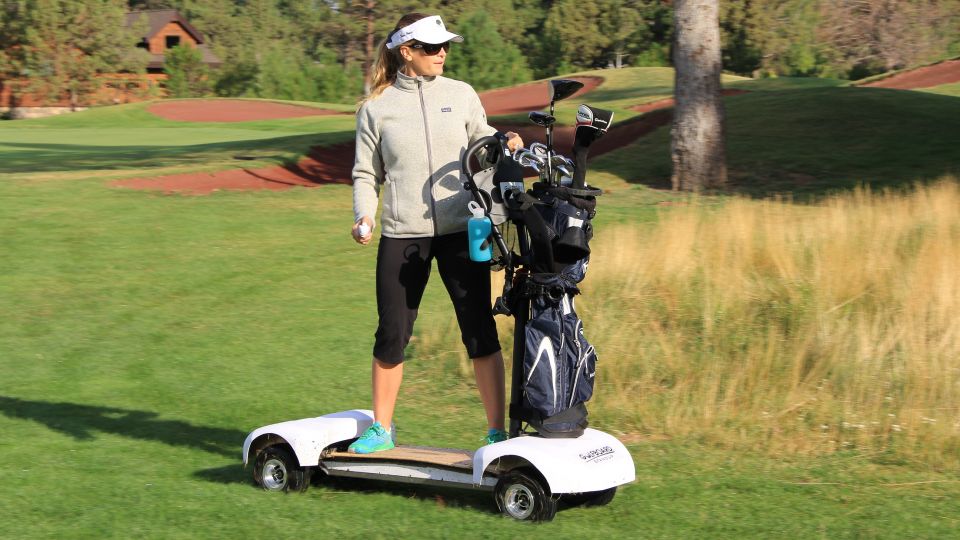For a long, grim while, golf suffered from a bleak environmental reputation, like the sports version of the Exxon Valdez.
But times have changed.
The game has gotten a whole lot greener, and not just because it sometimes lets its fairways go brown.
From solar-powered carts to biodegradable tees and drought-resistant grasses, the industry brims with products and practices designed to leave a lighter impact on the planet. In honor of Earth Day, let’s shine a light on them.
1. Solar Golf Cart Panels

Who says there’s nothing new under the sun? Designed to fit almost any golf cart, PowerFilm Solar Golf Cart Panels attach easily to your buggy’s rooftop, where they harness energy from above, reducing the need for battery-charging and extending the cart’s range by up to 20 percent.
2. Recycled Golf Balls

According to some estimates, more than 300 million golf balls get lost each year. But just because you can’t find them doesn’t mean they aren’t still lying around, littering forests, polluting ponds and streams. LostGolfBalls.com is a Texas-based outfit that does a lot of looking. In 2015 alone, the company tracked down 50 million of those wayward balls, cleaned up them up and put them back into play. You could say that they’re in the mulligan business, and that do-overs do a world of good.
3. The Bandon Preserve

True to its name, the 13-hole par-3 track at Bandon Dunes operates with an eco-conscious bent. Net proceeds from its greens fees go toward the Wild Rivers Coast Alliance, an organization devoted to ecological initiatives along the southern Oregon coast.
4. Drought-Resistant & Salt-Tolerant Grasses

Sunday Ultra-Dwarf is not one of Snow White’s buddies. It’s one of a dizzying array of turf grasses that golf courses have embraced as a means of minimizing their environmental impact. Platinum TE. Agrostis pallens. Tifway 419. The list goes on, and so do the grasses, carpeting layouts around the globe.
5. Durable and Dissolvable Tees

We’ve all seen tee boxes that the look like battlegrounds, their square-footage strewn with wooden and synthetic shards. It ain’t pretty. But the industry has ways to reduce that refuse. Take, for instance, CHAMP FLYTees, which are made from recyclable plastic and designed to take a beating without breaking. Consider, too, the swelling popularity of golf tees fashioned out of corn starch. Even if you leave them behind, eventually they’ll leave no trace.
6. Eco-Friendly Attire

Two words: Collared Greens. OK, a few more words. It’s an Idaho-based outfit that produces a range of environmentally friendly clothing, including 97-percent organic cotton polos, and 100 percent organic cotton hats, visors and sunglass straps. The company doesn’t simply go for green; it gives to green as well, donating a percentage of its proceeds to conservation-minded causes.
7. Surfing the Turf

Golf is best when you get around on foot. But if you absolutely, positively have to ride, the GolfBoard is a pretty green way to go. Powered by an eco-friendly lithium-ion battery, the low-slow vehicle goes easy on the earth, and though the ride itself has elements of surfing, snowboarding and skateboarding, it’s far easier to master than any of those three.
8. Biodegradable Balls

Think of all the golf balls that get banged off beaches, riverbanks and boats, destined to become flotsam and jetsam. Now envision the Ecobioball, which begins to biodegrade the instant it hits the water, exposing a fish-food core.
9. Eco-Conscious Courses

It’s not easy being green, but a growing number of golf properties are doing their best. They range from Kiawah Island Golf Resort in South Carolina, where all five courses, replete with resorted wetlands and water-saving irrigation systems, have been designated as Audubon Cooperative Sanctuaries; to chemical-and-pesticide free Applewood Golf Course in Colorado; to Yocha Dehe Golf Course in California, which uses recycled grease from its resort restaurants to help power its maintenance equipment.








